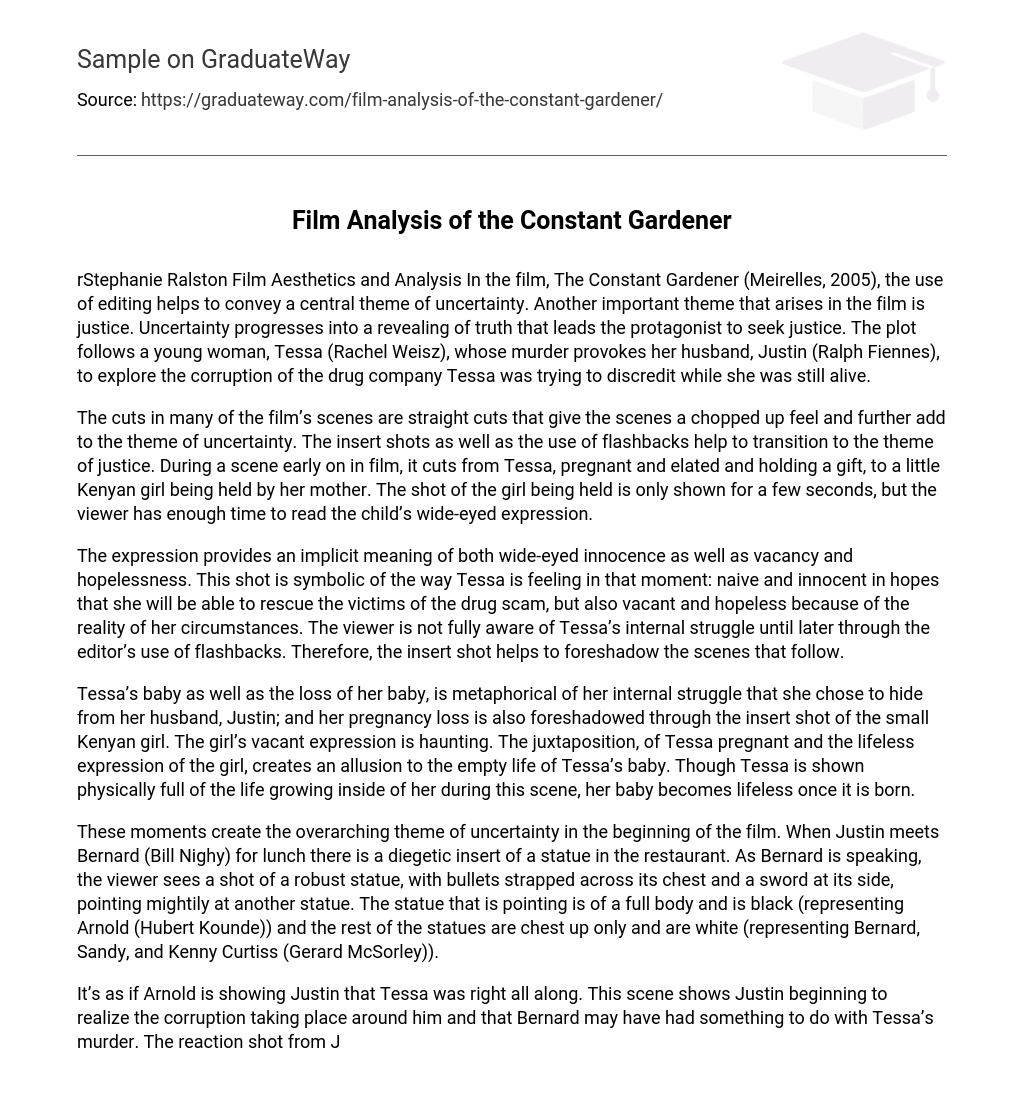rStephanie Ralston Film Aesthetics and Analysis In the film, The Constant Gardener (Meirelles, 2005), the use of editing helps to convey a central theme of uncertainty. Another important theme that arises in the film is justice. Uncertainty progresses into a revealing of truth that leads the protagonist to seek justice. The plot follows a young woman, Tessa (Rachel Weisz), whose murder provokes her husband, Justin (Ralph Fiennes), to explore the corruption of the drug company Tessa was trying to discredit while she was still alive.
The cuts in many of the film’s scenes are straight cuts that give the scenes a chopped up feel and further add to the theme of uncertainty. The insert shots as well as the use of flashbacks help to transition to the theme of justice. During a scene early on in film, it cuts from Tessa, pregnant and elated and holding a gift, to a little Kenyan girl being held by her mother. The shot of the girl being held is only shown for a few seconds, but the viewer has enough time to read the child’s wide-eyed expression.
The expression provides an implicit meaning of both wide-eyed innocence as well as vacancy and hopelessness. This shot is symbolic of the way Tessa is feeling in that moment: naive and innocent in hopes that she will be able to rescue the victims of the drug scam, but also vacant and hopeless because of the reality of her circumstances. The viewer is not fully aware of Tessa’s internal struggle until later through the editor’s use of flashbacks. Therefore, the insert shot helps to foreshadow the scenes that follow.
Tessa’s baby as well as the loss of her baby, is metaphorical of her internal struggle that she chose to hide from her husband, Justin; and her pregnancy loss is also foreshadowed through the insert shot of the small Kenyan girl. The girl’s vacant expression is haunting. The juxtaposition, of Tessa pregnant and the lifeless expression of the girl, creates an allusion to the empty life of Tessa’s baby. Though Tessa is shown physically full of the life growing inside of her during this scene, her baby becomes lifeless once it is born.
These moments create the overarching theme of uncertainty in the beginning of the film. When Justin meets Bernard (Bill Nighy) for lunch there is a diegetic insert of a statue in the restaurant. As Bernard is speaking, the viewer sees a shot of a robust statue, with bullets strapped across its chest and a sword at its side, pointing mightily at another statue. The statue that is pointing is of a full body and is black (representing Arnold (Hubert Kounde)) and the rest of the statues are chest up only and are white (representing Bernard, Sandy, and Kenny Curtiss (Gerard McSorley)).
It’s as if Arnold is showing Justin that Tessa was right all along. This scene shows Justin beginning to realize the corruption taking place around him and that Bernard may have had something to do with Tessa’s murder. The reaction shot from Justin, when Kenny makes a snide remark comparing Justin’s wife to a bitch, marks a turning point in the film from Justin’s uncertainty to a desire to bring justice to the situation. His face does not just show anguish and confusion anymore; his expression is vengeful and primal.
Another turning point occurs during the scene where there is a cutaway with the train and Justin. During this scene, the viewer sees Justin, through his performance, decide to believe in Tessa and to avenge her and justify her death. Next, the flashbacks of Justin and Tessa when they first met, happy and so in love, are crosscut with Justin mourning Tessa’s loss in the rain. This scene solidifies Justin’s need for justice for his wife, as he remembers what a wonderful, selfless person she was.
The Constant Gardener’s use of editing plays a large role in conveying two of the film’s central themes: uncertainty and justice. As the film begins, the editing plays to the role of creating a feeling of confusion and uneasiness using quick and frequent cuts. As the film progresses, the editors use insert shots, flashbacks, cutaways, and crosscutting to convey the message of justice. Justin’s love for Tessa abounds even through his uncertainty and provokes him to do what he feels is right and just even if it costs him his life.





